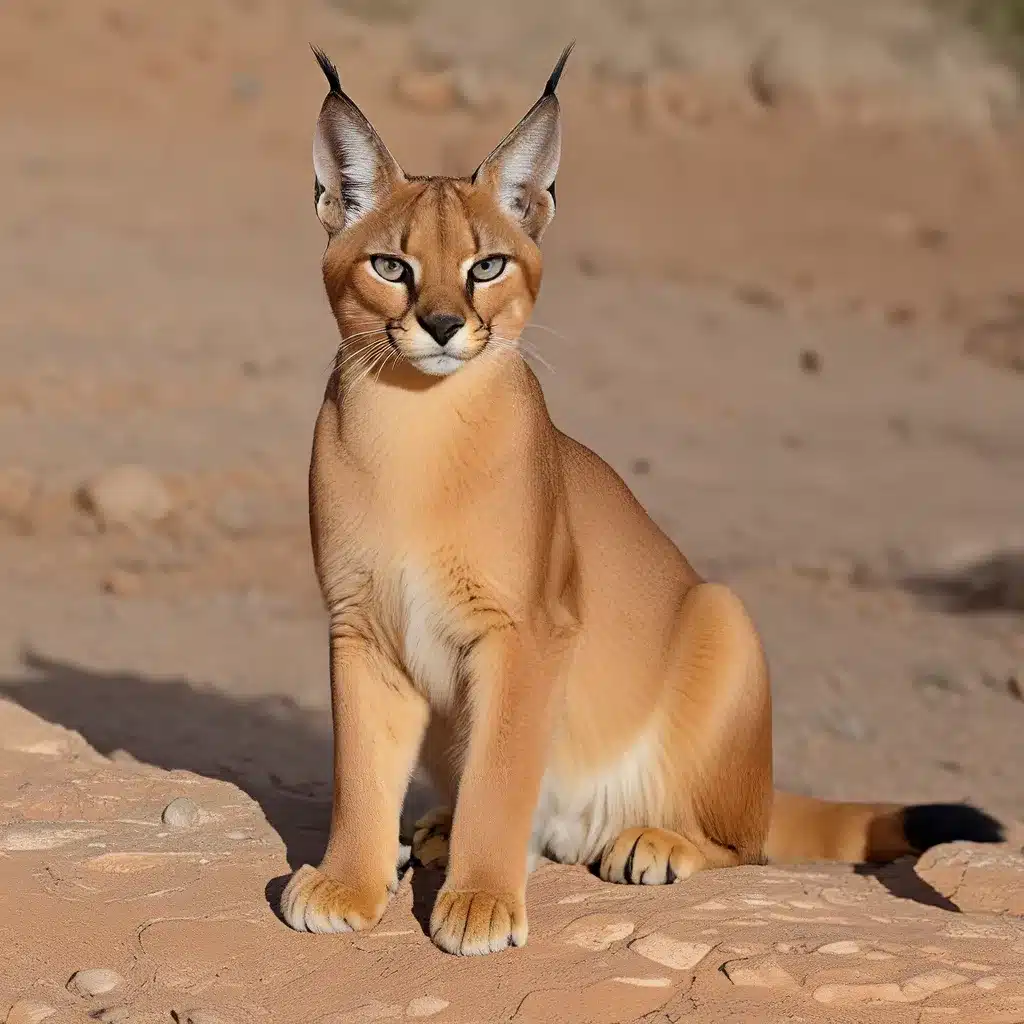
The Allure of the Caracal
There’s something inherently captivating about the caracal, that elusive feline prowling the vast, arid landscapes of the desert. Its enigmatic persona and striking features have long enthralled nature enthusiasts and wildlife aficionados alike. As I delve into the fascinating world of this desert-dwelling cat, I can’t help but feel a sense of wonder and intrigue. What secrets does the caracal hold, hidden within the rugged expanse of its natural habitat?
Unmasking the Caracal’s Mystique
The caracal, often referred to as the “desert lynx,” is a species of medium-sized wild cat found in parts of the Middle East, Central Asia, and Africa. With its distinctive tufted ears, sleek tawny coat, and agile movements, this feline has a truly captivating presence. But what truly sets the caracal apart is its air of mystery – it’s a creature that seems to exist in the shadows, evading the prying eyes of human observers.
As I delve deeper into the caracal’s world, I’m struck by the sheer adaptability of this remarkable animal. Its ability to thrive in the harsh, arid conditions of the desert is nothing short of impressive. From its keen senses and lightning-fast reflexes to its remarkable hunting prowess, the caracal is a true master of its environment.
Unveiling the Caracal’s Hunting Prowess
One of the most captivating aspects of the caracal is its hunting behavior. These felines are known for their incredible leaping ability, capable of pouncing on prey from heights of up to 3 meters. Their large paws and sharp claws make them formidable hunters, able to take down prey ranging from small rodents to birds and even young gazelles.
The caracal’s hunting tactics are truly awe-inspiring. They often employ a stealth-like approach, carefully stalking their prey before unleashing a lightning-fast attack. And if that weren’t impressive enough, these cats are also skilled climbers, able to scale rocky outcrops and trees with ease in pursuit of their quarry.
But what really sets the caracal apart is its remarkable ability to adapt its hunting strategies to the ever-changing desert environment. Whether it’s navigating the shifting sands, tracking elusive prey, or evading predators, this feline is a true master of its domain.
The Caracal’s Mysterious Lifestyle
As I continue to unravel the mysteries of the caracal, I’m struck by the sheer enigma that surrounds this captivating creature. Despite their widespread distribution across the desert regions of the Middle East and Africa, these cats remain largely elusive and difficult to observe in the wild.
Their solitary, nocturnal nature and ability to blend seamlessly into their surroundings make them true masters of stealth. It’s not uncommon for caracals to go unnoticed, even in areas where they are known to roam.
But what really fascinates me is the caracal’s intricate social structure and territorial behavior. These cats are highly territorial, with males and females maintaining their own distinct domains. They communicate through a variety of vocalizations, including a haunting, resonant call that echoes across the desert landscape.
Conserving the Caracal’s Captivating Presence
As I delve deeper into the world of the caracal, I can’t help but feel a growing sense of concern for the future of this enigmatic feline. Like many of the world’s wild animals, the caracal faces a host of threats, from habitat loss and fragmentation to human-wildlife conflict and poaching.
It’s a sobering realization, but one that also underscores the importance of conservation efforts to protect this captivating species. From collaborating with local communities to raising awareness and supporting research, there are countless ways that we can work to safeguard the caracal’s future.
Exploring the Caracal’s Desert Domain
As I contemplate the caracal’s plight, my mind inevitably drifts back to the vast, captivating landscapes that these felines call home. The deserts of the Middle East and Africa are truly remarkable, with their sweeping sand dunes, dramatic rock formations, and oases of lush greenery.
These arid environments are the perfect backdrop for the caracal’s mysterious existence, a world of contrasts and extremes that seems to mirror the feline’s own enigmatic nature. From the scorching heat of the day to the chilly nights, the desert is a place of constant change and adaptation.
As I imagine the caracal prowling through this rugged landscape, I can’t help but feel a sense of awe and reverence. It’s a testament to the incredible resilience and adaptability of life, a reminder that even in the harshest of environments, there are creatures that have found a way to thrive.
Embracing the Caracal’s Captivating Allure
As I reflect on my journey of discovery into the world of the caracal, I can’t help but feel a profound sense of appreciation and admiration for this remarkable feline. Its captivating presence, enigmatic nature, and remarkable adaptability have left an indelible mark on me.
In a world that often seems to be moving at breakneck speed, the caracal serves as a reminder to slow down, to observe, and to appreciate the wonders of the natural world. Its very existence is a testament to the enduring resilience of life, a beacon of hope in a landscape that can sometimes appear harsh and unforgiving.
And so, as I bid farewell to the caracal and its desert domain, I can’t help but feel a sense of excitement and anticipation. For in the captivating allure of this feline, I see a world of possibility, a realm of discovery and wonder that is just waiting to be explored. Who knows what other secrets the desert might hold, waiting to be unveiled?

